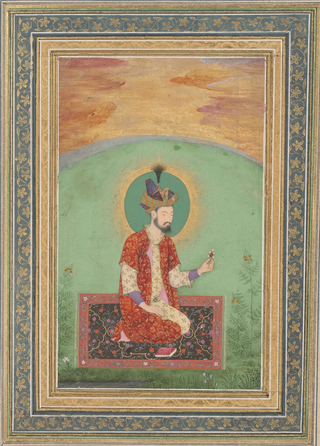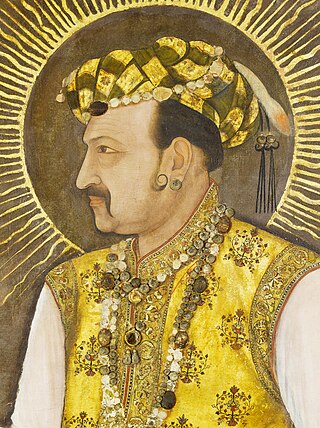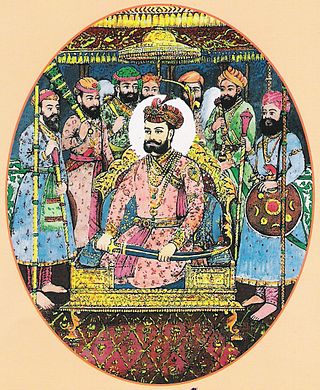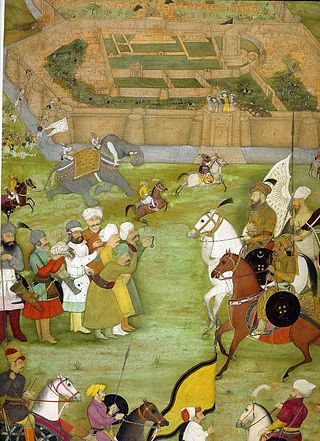Related Research Articles

Nasir al-Din Muhammad ) commonly known by his regnal name Humayun, was the second Mughal emperor, who ruled over territory in what is now Eastern Afghanistan, Bangladesh, Northern India, and Pakistan from 1530 to 1540 and again from 1555 to his death in 1556. At the time of his death, the Mughal Empire spanned almost one million square kilometers.

Nur-ud-Din Muhammad Salim, known by his imperial name Jahangir, was the fourth Mughal Emperor, who ruled from 1605 till his death in 1627.

Mirza Shahab-ud-Din Muhammad Khurram, also known as Shah Jahan I, was the fifth Mughal emperor, reigning from 1628 until 1658. During his reign, the Mughals reached the peak of their architectural and cultural achievements.

The Second Battle of Panipat was fought on 5 November 1556, between Akbar and the king of Delhi, Hemu. Hemu had conquered Delhi and Agra a few weeks earlier by defeating Mughal forces under Tardi Beg Khan in the battle of Delhi and crowned himself Raja Vikramaditya at Purana Quila in Delhi.

Akbar II, also known as Akbar Shah II, was the nineteenth Mughal emperor from 1806 to 1837. He was the second son of Shah Alam II and the father of Bahadur Shah II, who would eventually succeed him and become the last Mughal emperor.

Mandu or Mandavgad is an ancient city in the present-day Mandav area of the Dhar district. It is located in the Malwa and Nimar region of western Madhya Pradesh, India, at 35 km from Dhar city. In the 11th century, Mandu was the sub division of the Tarangagadh or Taranga kingdom. This fortress town on a rocky outcrop about 100 km (62 mi) from Indore is celebrated for its architecture.

The Agra Fort is a historical fort in the city of Agra, and also known as Agra's Red Fort. Mughal emperor Humayun was crowned at this fort. It was later renovated by the Mughal emperor Akbar from 1565 and the present-day structure was completed in 1573. It served as the main residence of the rulers of the Mughal dynasty until 1638, when the capital was shifted from Agra to Delhi. It was also known as the "Lal-Qila" or "Qila-i-Akbari". Before being captured by the British, the last Indian rulers to have occupied it were the Marathas. In 1983, the Agra fort was inscribed as a UNESCO World Heritage Site because of its importance during the Mughal Dynasty. It is about 2.5 kilometers (1.6 mi) northwest of its more famous sister monument, the Taj Mahal. The fort can be more accurately described as a walled city. It was later renovated by Shah Jahan.

Hemu was an Indian emperor who previously served as a general and Wazir of Adil Shah Suri of Sur Empire during a period in Indian history when Mughals and Afghans were vying for power across North India. He fought Afghan rebels across North India from Punjab to Bengal and Mughal forces of Humayun and Akbar in Agra and Delhi, winning 22 battles for Adil Shah Suri.

Mughal architecture is the type of Indo-Islamic architecture developed by the Mughals in the 16th, 17th and 18th centuries throughout the ever-changing extent of their empire in the Indian subcontinent. It developed from the architectural styles of earlier Muslim dynasties in India and from Iranian and Central Asian architectural traditions, particularly Timurid architecture. It also further incorporated and syncretized influences from wider Indian architecture, especially during the reign of Akbar. Mughal buildings have a uniform pattern of structure and character, including large bulbous domes, slender minarets at the corners, massive halls, large vaulted gateways, and delicate ornamentation; examples of the style can be found in modern-day Afghanistan, Bangladesh, India and Pakistan.

Mughal painting is a South Asian style of painting on paper confined to miniatures either as book illustrations or as single works to be kept in albums (muraqqa), originating from the territory of the Mughal Empire in the Indian subcontinent. It emerged from Persian miniature painting and developed in the court of the Mughal Empire of the 16th to 18th centuries. Battles, legendary stories, hunting scenes, wildlife, royal life, mythology, as well as other subjects have all been frequently depicted in paintings.
The Farooqi dynasty or the Farooq Shahi was the ruling dynasty of the Khandesh Sultanate from its inception in 1382 till its annexation by the Mughal emperor Akbar in 1601. The founder of the dynasty, Malik Ahmad participated in a rebellion against the Bahmani ruler Muhmmad Shah I in his early years. When he was compelled to flee from Deccan, he established in Thalner on the Tapti River. After receiving the grant of the fiefdoms of Thalner and Karanda from Firuz Shah Tughluq in 1370, he conquered the region around Thalner, which later became known as Khandesh. By 1382, he started ruling independently.

Syed Shah Jamal Uddin Naqvi Bukhari also known as Baba Shah Jamal was a Sufi saint. He is also known as Hussaini Syed.

Abu'l-Fath Jalal-ud-din Muhammad Akbar, popularly known as Akbar the Great, and also as Akbar I, was the third Mughal emperor, who reigned from 1556 to 1605. Akbar succeeded his father, Humayun, under a regent, Bairam Khan, who helped the young emperor expand and consolidate Mughal domains in the Indian subcontinent.

The Bengali Calendar or Bangla Calendar, colloquially, is a solar calendar used in the Bengal region of the South Asia. A revised version of the calendar is the national and official calendar in Bangladesh and an earlier version of the calendar is followed in the Indian states of West Bengal, Tripura and Assam. Unlike the traditional Indian Hindu calendar which starts with the month of Chaitra, the Bengali calendar starts with Boishakh because of the reforms made during the reign of the Mughal Emperor Akbar in Mughal Bengal. The first day of the Bengali year is known as Pohela Boishakh which is a public holiday in Bangladesh.
Events in the year 1806 in India.
Muhammad Saifullah bin Mohammad Akbar is a Singaporean professional footballer who plays as a attacking midfielder for Tampines Rovers and the Singapore national team.

The last two Gujarat Sultans, Ahmad Shah III and Mahmud Shah III, were raised to throne when they were young so the nobles were ruling the Sultanate. The nobles divided territories between themselves but soon started fighting between themselves for supremacy. One noble invited the Mughal emperor Akbar to intervene in 1572 which resulted in the conquest of Gujarat by 1573 and Gujarat becoming the province of the Mughal Empire.

The foreign relations of the Mughal Empire were characterized by competition with the Persian Empire to the west, the Marathas and others to the south, and the British to the east. Steps were taken by successive Mughal rulers to secure the western frontiers of India. The Khyber Pass along the Kabul- Qandahar route was the natural defence for India, and their foreign policy revolved around securing these outposts, as also balancing the rise of powerful empires in the region. During the break up of the Timurid Empire in the 15th century, the Ottomans in Turkey, the Safavids in Persia and the Uzbegs in central Asia emerged as the new contenders of power. While the Safavids were Shia by faith, Ottomans along with Uzbegs were Sunni. The Mughals were also Sunni and Uzbegs were their natural enemies, who caused Babur and other Timurid princes to leave Khurasan and Samarqand. The powerful Uzbegs who held sway over central India sought an alliance of Sunni powers to defeat the Shia ruled Persia, but Mughals were too broadminded to be driven away by the sectarian conflicts. The Mughal rulers, especially Akbar, were keen to develop strong ties with Persia in order to balance the warring Uzbegs. Thus, the foreign policy of Mughals was centred around strengthening the ties with Persia, while maintaining the balance of power in the region by keeping a check on the evolution of a united Uzbeg empire.
The 2022 Singapore Premier League was the 5th season of the Singapore Premier League, the top-flight Singaporean professional league for association football clubs, since its rebranding in 2018. The champions of the 2022 Singapore Premier League should have qualified for the AFC Champions League. The season began in March and ended on 15 October.